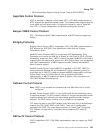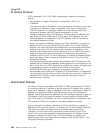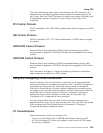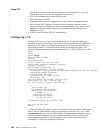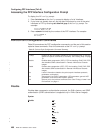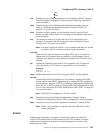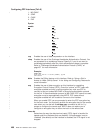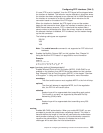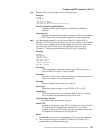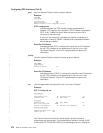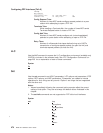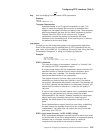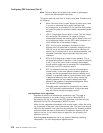If Lower DTR is set to “enabled”, then the DTR signal will be dropped when
the interface is disabled. This behavior may be desirable in situations where
the interface has been configured as an alternate link for WAN Reroute and
the interface is connected to a dial-out modem which maintains its dial
connection based on the state of the DTR signal.
When the interface is disabled, the DTR signal is low and the modem
keeps the dial connection down. When the interface is enabled, due to a
WAN Reroute backup scenario, DTR is raised and the modem dials a
stored number to the backup site. When the primary interface is restored,
the alternate interface is disabled, DTR is lowered, and the modem hangs
up the dial connection.
The following cable types are supported:
RS-232
V.35
V.36
Note: The enable lower-dtr command is not supported on PPP dial circuit
interfaces.
mp Enables the Multilink Protocol (MP) on this interface. See “Chapter 34.
Using the Multilink PPP Protocol” on page 509 for more information.
Example:
enable mp
Enabled as a MP link
Is this link a dedicated MP link? [no] yes
MP interface for this MP link? [0] 3
mppe
[mandatory/optional] [stateless/stateful]
Enables Microsoft Point-to-Point Encryption (MPPE). If MS-CHAP is not
enabled on the interface, then MPPE cannot be enabled on that interface.
See “Microsoft Point-to-Point Encryption (MPPE)” in the chapter “Overview
of Encryption” in
Using and Configuring Features
for more information.
mandatory
The client and the server must negotiate MPPE or the link will drop.
optional
The client will attempt to negotiate MPPE, but if the negotiation
fails, the PPP link will remain active.
stateless
Session keys will be regenerated after transmitting each packet.
This function is currently not supported by Microsoft Dial-Up
Networking (DUN) clients.
stateful
Session keys will be regenerated after transmitting every 256
packets.
mschap
Enables MS-CHAP authentication. When you enable MS-CHAP, you are
prompted to provide the authenticator rechallenge interval. This value in
seconds defines the length of time that will pass before the authenticator
sends another challenge to the receiver of the authentication request to
reconfirm the authentication. The value 0 indicates that no further
challenges will be sent after the initial authentication.
Configuring PPP Interfaces (Talk 6)
Chapter 33. Configuring and Monitoring Point-to-Point Protocol Interfaces 469
|
|
|
|
|
|
|
|
|
|
|
|
|
|
|
|
|
|
|
|
|
|
|
|



